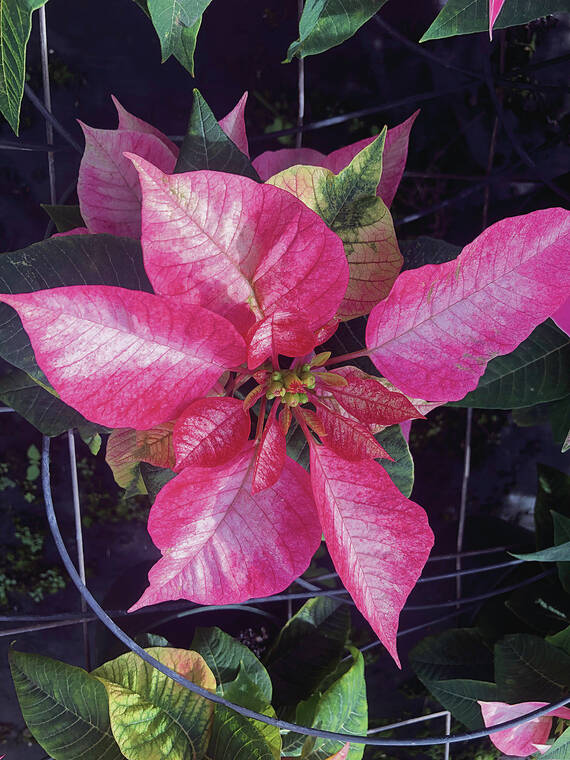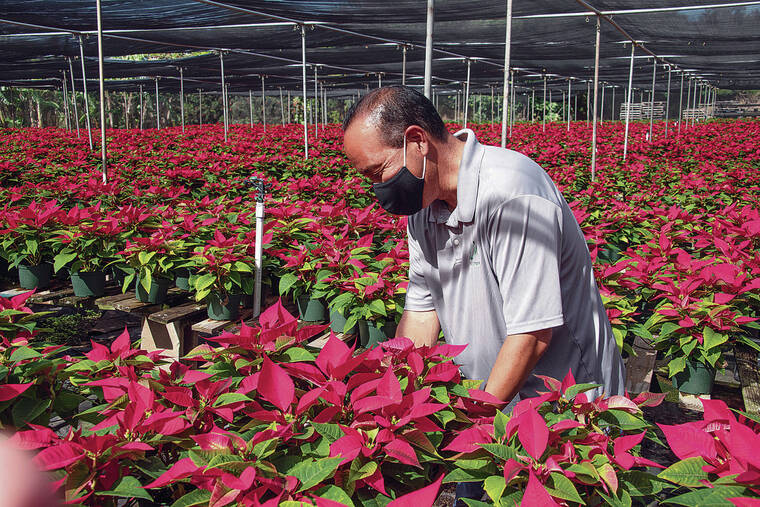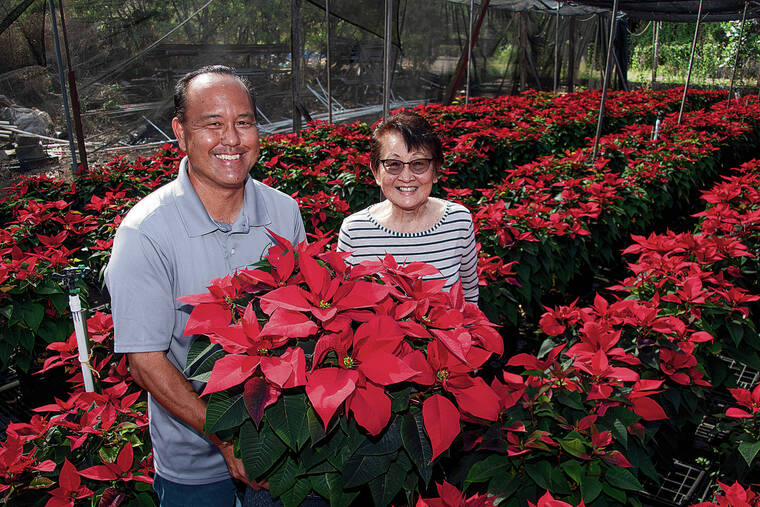This month, thousands of rows of poinsettias at the Alluvion Inc. nursery/florist in Haleiwa turned red, pink and white just in time for holiday decorations, the culmination of meticulous cultivation that started in July.
The striking red variety may be the most iconic flower of the Christmas season, but it and all of its colorful cousins have a finicky reputation. It’s a tricky, tedious growing process that demands paying attention to detail, said nurseryman Chad Matsushima.
After several years in charge of the wholesaler’s main crop, Matsushima said, “Like kids, it takes a lot to raise them. It’s still a challenge to get a nice poinsettia crop.”
He feels the pain of the average buyer who can’t figure out why the leaves drop off when they take the flower home, the whole plant withers or they can’t keep those fuzzy, white bugs from eating it alive after Christmas.
Gardening websites list several common reasons: mostly overwatering or underwatering, sharp changes in temperature and humidity, and too much or too little sunlight.
Matsushima nodded in sympathy and offered a few tips on how to make poinsettias last through the holiday season. “Pick one that looks good to start with,” passing over plants with yellowing leaves, sparse leaves on the bottom or with broken branches.
Water two to three times per week to prevent the plant from drying out completely, he said. It needs watering when the top 1 or 2 inches of the soil get dry and the pot feels light in weight. Take it out of the foil or paper cover and allow excess water to drain into the kitchen sink so the roots don’t sit in water and rot, he said. But it’s also important to let the poinsettia dry out a little between waterings, Matsushima added.
Alluvion grows its poinsettias under tents of shadecloth because they like indirect light, so he recommends putting them close to a window. Some people grow their poinsettias outside and bring them indoors for the holidays, but some plants might not transition well.
He doesn’t have experience growing the plants year-round, but the conventional advice is to prune the plants back in April and August, he said.
At Alluvion, “every year we start over” with new cuttings from the mainland, Matsushima said. He starts planting after the Fourth of July and completes the bulk of it during the first weeks of August.
The plants are highly susceptible to insects and diseases, and are especially vulnerable to whitefly — “it’s a battle.” They need to be sprayed for both when necessary, and fertilized with a 20-20-20 formula. Branches need to be pinched back to induce fuller leaf spread, and their height must be controlled in proportion to the size of the pot. Taller plants need to be staked and supported with string.
Once they’re ready to be sold — the first batch in mid-November — they require careful handling to avoid damage, sometimes involving boxes or paper wrapping in preparation for delivery, especially to the neighbor islands.
THE NURSERY started growing poinsettias 15 years ago, becoming one of the top growers on Oahu, said Susan Matsushima, Chad’s mother. She started the company in 1996 and is now in charge of floral arrangements. They learned how to grow poinsettias from another grower who later joined the company, but now, “this is Chad’s baby,” she said.
This year, Alluvion has produced 18,000 poinsettias, most of them pre-sold to stores, hotels and corporations throughout the state, Chad Matsushima said. The best-selling item is a red poinsettia in a 6-inch pot.
The poinsettias start to turn color with cooler temperatures and longer nights as part of a natural cycle — the first ones about late October this year. It takes three to four weeks for the bracts to achieve full color, he said. The bracts are the leaves that turn color, not the actual flower.
(The true flowers are the small, yellow buttons, called cyathia, which can be seen in the center of each rosette of colorful bracts, according to a 2009 University of Hawaii agricultural extension service report.)
Plants that are smaller and bushier last longer, in terms of sturdiness and attractiveness, than the taller, leggier plants, Matsushima said. The company carries five varieties of red, which each turn color at different times during the season; they don’t want all the plants to turn color at the same time because they must be able to meet customer demand throughout the extended holiday season.
The nursery doesn’t have to trick the bracts into turning color. According to conventional wisdom, that is achieved by keeping the plants in the dark. Hawaii averages 12 hours of darkness from September to December, and Alluvion is in a location not exposed to many house and street lights at night.
However, the UH agricultural report gave this advice on tricking the poinsettias into changing color:
“The colorful bracts form only when nights are long — 12 hours or more. This means that plants must not be exposed to light at night after Sept. 21. They must be in a dark area completely away from streetlights or house lights. If you do not have a completely dark area outside, you can put them in an unlighted room, closet, or lightproof box each evening for at least 12 hours.
“They also require full sun during the day, so be sure to return them to a sunny location outside after their stay in the dark. Depending on the variety you are growing, you should begin to see colored bracts in 6 to 9 weeks. Continue monthly applications of fertilizer until the true flowers (cyathia) develop. The plant no longer needs to be kept in the dark or be fertilized once the true flowers appear.”
The report concluded: “You may find this process to be quite time consuming! If so, it is always good to support your local nurseries and purchase fresh poinsettias each year.”
And surprise: The Matsushimas totally agree. Smiling, Susan Matsushima said, “We don’t want people to grow poinsettias the whole year —” Her son finished: “ — We want them to buy new ones next year!”
—
Alluvion Inc.
61-676 Kamehameha Hwy., Haleiwa
Info: 637-8835; alluvionhi.com
Is there a gardening topic you’d like to read about in the Garden Variety column? Email Pat Gee at pgee@staradvertiser.com with your request.








